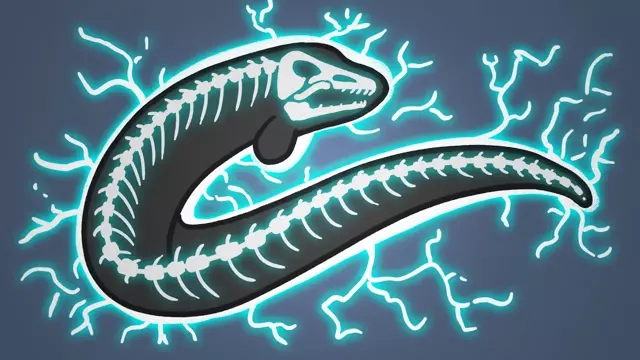2023-12-20
[public] 118K views, 12.4K likes, dislikes audio only
Check out @MinutoDaTerra and join our Patreon community at https://patreon.com/minuteearth. (Links to other language channels down in the description)
Electric eels can emit some of the largest shocks in the animal kingdom - but why don't they shock themselves?
LEARN MORE
**************
To learn more about this topic, start your googling with these keywords:
- Electrocyte: a modified muscle or nerve cell that generates electricity in the electric organ of certain fishes
SUPPORT MINUTEEARTH
**************************
If you like what we do, you can help us!:
- Become our patron: https://patreon.com/MinuteEarth
- Our merch: http://dftba.com/minuteearth
- Our book: https://minuteearth.com/books
- Share this video with your friends and family
- Leave us a comment (we read them!)
CREDITS
*********
Leonardo Souza | Script Writer and Narrator
Kate Yoshida | Script Editor
David Goldenberg | Director
Lizah van der Aart | Illustration, Video Editing and Animation
Nathaniel Schroeder | Music
MinuteEarth is produced by Neptune Studios LLC
OUR STAFF
************
Lizah van der Aart • Sarah Berman • Cameron Duke
Arcadi Garcia i Rius • David Goldenberg • Melissa Hayes
Alex Reich • Henry Reich • Peter Reich
Ever Salazar • Leonardo Souza • Kate Yoshida
OUR LINKS
************
Youtube | https://youtube.com/MinuteEarth
TikTok | https://tiktok.com/@minuteearth
Twitter | https://twitter.com/MinuteEarth
Instagram | https://instagram.com/minute_earth
Facebook | https://facebook.com/Minuteearth
Website | https://minuteearth.com
Apple Podcasts| https://podcasts.apple.com/us/podcast/minuteearth/id649211176
MinuteEarth (and MinutePhysics) in other Languages:
Portuguese
https://www.youtube.com/@MinutoDaTerra
https://www.youtube.com/@MinutoDaFisica
Spanish
https://www.youtube.com/@MinutoDeLaTierra
https://www.youtube.com/@minutodefisica
Catalán
https://www.youtube.com/@MinutdelaTerra
French
https://www.youtube.com/@MinuteDePhysique
https://www.youtube.com/@MinutePourLaTerre
Chinese
https://www.youtube.com/@MinutePhysicsCN
https://www.youtube.com/@MinuteEarthCN
Russian
https://www.youtube.com/@MinutePhysicsRU
Georgian
https://www.youtube.com/@MinuteGeorgian
Polish
https://www.youtube.com/@minuta.z.ziemia
German
https://www.youtube.com/@paarMinutenErde
Arabic
https://www.youtube.com/channel/UC_6luMR5xA4lRBA2mq53JEQ
Tamil
https://www.youtube.com/channel/UCIrFGdwp_FzEkF7uHEjSShw
Turkish
https://www.youtube.com/@DakikaFizik
REFERENCES
**************
Raimundo Nonato Gomes Mendes Júnior (2023). Analista Ambiental, Instituto Chico Mendes de Conservação da Biodiversidade. Personal Communication
Babineau D, Longtin A, & Lewis JE (2006). Modeling the electric field of weakly electric fish. Journal of Experimental Biology 209: 3636–3651. https://doi.org/10.1242/jeb.02403
Bauer, R (1979). Electric organ discharge (EOD) and prey capture behaviour in the electric eel, Electrophorus electricus. Behavioral Ecology and Sociobiology 4: 311–319.
Bennett, MVL(1971).Electric organs. In Fish Physiology, W.S. Hoar, and D.J. Randall,eds. (AcademicPress),pp.347–491. https://doi.org/10.1007/BF00303239
Catania K (2014). The shocking predatory strike of the electric eel. Science 346, 1231–1234 (2014). https://doi.org/10.1126/science.1260807
Catania, KC (2015). Electric Eels Concentrate Their Electric Field to Induce Involuntary Fatigue in Struggling Prey. Current Biology, 25(22), 2889–2898. https://doi.org/10.1016/j.cub.2015.09.036
Catania, K.C. (2015). An optimized biological TASER: electric eels remotely induce or arrest movement in nearby prey. Brain, Behavior and Evolution 86: 38–47. https://doi.org/10.1159/000435945
de Santana, C et al. (2019). Unexpected species diversity in electric eels with a description of the strongest living bioelectricity generator. Nature Communications, 10(1), 4000–. https://doi.org/10.1038/s41467-019-11690-z
Markham MR (2013). Electrocyte physiology: 50 years later. Journal of Experimental Biology, 216(13), 2451–2458. https://doi.org/10.1242/jeb.082628
/youtube/video/tUfvOTYBXQQ?t=18
https://patreon.com/minuteearth
/youtube/video/nxDVBDyAM7I

